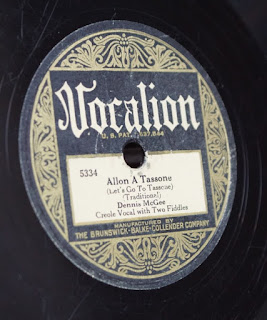There was an old man in the community who was always promoting different things. He asked this man that I was working with if he thought we would like to make some records. He said, "I wonder if Dennis and Sady would go and make some records". That was the old 78s at that time. So [Wade] Fruge asked me and I asked Dennis. He had said, "They would pay all your expenses" but that was it. Just our expenses you know.4
Allons! Aller à grand Tasso, mais, c’est pour voir les belles petites chères,
Allons! Aller, mais, à grand Tasso, mais, c’est pour voir les belles bouclés,
Allons! Aller à grand Tasso pour voir les belles bouclés.Gardez-donc, mais, ces belles jeunes, mais, ils sont si bonnes, mais, les danseurs,Ça danse bien, mais, ç’a la bonne vie, c’était joli, les chers p’tit cœurs,Gardez-donc, mais, c’est si mignonne, malheureuse, dit "Bye bye".Je suis après, mais, m’en aller, mais ouais, là-bas, mais, à Tasso,C’est pour voir les belles p’tites, oh yé yaille, malheureuse,C’est là je vas m’en aller, si loin, mais, c’est pour voir, mais, les belles filles.Allons! Aller, mais, s’en aller, oh là-bas, mais, p’tit monde, mais malheureuse,Je vas aller, mais, m’en aller à Tasso, c’est pour voir les chères mignonnes.
 |
| Sady Courville 1 |
Courville and McGee took a trip to New Orleans in March of 1929 and recorded eight tunes for Vocalion records including this song. Sady continues:
And I had this old fiddle here. I had it in a flour sack. I didn't even have a case for it. So we got on a train here one morning and went to New Orleans, somewhere in the French Quarter on the second floor, and we made those records. We made about either or ten of them.4
"Allon A Tassone" (#5334) is an ode to the Louisiana community of Tasso, east of Eunice, Louisiana where Dennis would visit and see the beautiful curly haired girls. The term "tasso" first appears in the Louisiana documentary record in 1859 as the name of a prairie community near present-day Duson, in the heart of the early Cajun ranching country. In 1880, Goerge Washington Cable collected notes on the Cajun community census report. His notes revealed "tassao" as a "jerked beef" near the Carencro area.2 Today, tasso is a type of spicy, heavily peppered and smoked pork found in Louisiana. Unlike ham, it's not made from the hind leg of a hog, but rather the hog's shoulder.
Let's go! Going to big Tasso, well, it's to see the beautiful little darlings,
Let's go! Going, well, to big Tasso, well, it's to see the beautiful curly haired ones,
Let's go! Going to big Tasso to see the beautiful curly haired ones.Look at that, well, those beautiful young ones, well, they are so good, well, dancers,That dance well, well, life is good, it's beautiful, dear little sweethearts,Look at that, well, it's so cute, oh my, say "bye bye".I have, well, went away, well yeh, over there, well, to Tasso,It's to see the little beauties, oh ye yaille, oh my,That's where I'm going to go, so far, well, it's to see , well, the beautiful girls.Let's go! Going to, well, go away, oh over there, well, my little everything, well oh my,I am going to, well, go away to Tasso, it's to see the darling cuties.
Like several of McGee's originals, the timing of the music seems to run everywhere. According to perspective given by a musician from California:
You play that Dennis McGee stuff, if you haven't heard it before, you can't guess why it's gonna have like three measures, four measures, two measures... or how it's going to go. You basically have to learn it and memorize it or count it... Alot of times playing with accordion, it is sort of like "Okay..." But when you start playing the Dennis McGee stuff, it's more intellectually challenging because you have to figure out where the song's going all the time... He reminds me of Mozart.1
- Negotiating Difference in French Louisiana Music: Categories, Stereotypes ... By Sara Le Menestrel
- Stir the Pot: The History of Cajun Cuisine By Marcelle Bienvenu, Carl A. Brasseaux, Ryan A. Brasseaux
- DENNIS MCGEE - Complete Early Recordings. Yazoo 1994. Liner notes.
- Cajun and Creole Music Makers By Barry Jean Ancelet
Find:
The Complete Early Recordings of Dennis McGee (Yazoo, 1994)
Cajun: Rare & Authentic (JSP, 2008)

Good post, Wade. Very informative. Growing up in Eunice in the '50's, I vaguely remember McGee lived a couple of blocks down from my grandmother's. Even fooled around with his kids for a short while, I remember. He sat on his porch a lot, fiddling.
ReplyDeleteI see my post above was designated "Unknown."
ReplyDeleteTed Fontenot